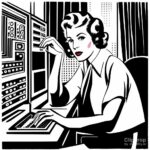(1968) The Mother of All Demos: Douglas Engelbart’s Computer Vision
“Douglas Engelbart’s visionary approach during The Mother of All Demos forever changed the way we interact with computers, laying the groundwork for modern computing and inspiring countless innovations that have shaped the digital world we inhabit today.”
~ Robert Lavigne, The Digital Grapevine
Revolutionary Innovations Unveiled at The Mother of All Demos
In 1968, the landscape of computer technology shifted dramatically as Douglas Engelbart, an American engineer and inventor, unveiled a groundbreaking demonstration that would forever change the way we interact with computers. Later christened as “The Mother of All Demos,” this remarkable event took place at the Fall Joint Computer Conference in San Francisco, offering a glimpse into Engelbart’s ambitious vision for the future of human-computer interaction.
During this captivating 90-minute presentation, Engelbart astounded the audience by introducing a series of revolutionary technologies and concepts that would lay the groundwork for modern computing. Among these pioneering innovations were the first instances of video conferencing, hypertext, collaborative real-time editing, and the now-ubiquitous computer mouse, which Engelbart had ingeniously invented in 1963.
The Revolutionary oN-Line System (NLS)
A central component of Engelbart’s demo was the oN-Line System (NLS), an early computer system meticulously developed at his research center, the Augmentation Research Center (ARC) at Stanford Research Institute (SRI). The NLS was ingeniously designed to facilitate collaboration and enhance productivity through a networked computing environment, foreshadowing the interconnected world we live in today.
The Mother of All Demos left an indelible mark on the computer industry, inspiring a generation of technologists and researchers to push the boundaries of what was possible. Many of the concepts and technologies showcased by Engelbart during his momentous demonstration would go on to become integral components of modern computing systems, including personal computers and the internet.
Through his visionary foresight and extraordinary demonstration, Douglas Engelbart played a pivotal role in shaping the future of computing and revolutionizing the way we interact with technology today. His work has left a lasting legacy, influencing countless innovations and paving the way for the digital age.
The Technologies Unveiled: A Closer Look
The Mother of All Demos showcased a myriad of groundbreaking technologies that would ultimately redefine the way we work and communicate. These innovations include:
- The Computer Mouse: Engelbart’s invention of the computer mouse revolutionized how users interact with computers, making it significantly more intuitive and user-friendly.
- Video Conferencing: The ability to conduct real-time video communication has transformed how businesses collaborate, breaking down geographical barriers and enabling more efficient global communication.
- Hypertext: This precursor to the World Wide Web has significantly impacted how information is organized and accessed, allowing users to easily navigate between interconnected documents and resources.
- Collaborative Real-Time Editing: By enabling multiple users to simultaneously edit documents, Engelbart paved the way for popular modern tools like Google Docs and Microsoft Office 365, which have become essential for teamwork and collaboration.
The Lasting Impact of Engelbart’s Vision
Douglas Engelbart’s influence stretches far beyond the technologies he introduced during The Mother of All Demos. His visionary approach to human-computer interaction has profoundly impacted the development of subsequent innovations, including:
- Graphical User Interfaces (GUIs): Engelbart’s work laid the foundation for the development of GUIs, which have made computing more accessible and user-friendly for people of all skill levels.
- The World Wide Web: Engelbart’s concepts of hypertext and networked computing played a significant role in the creation of the World Wide Web, revolutionizing how we access and share information.
- Social Media: The interconnected nature of Engelbart’s NLS foreshadowed the rise of social media, which has transformed how we communicate, share ideas, and build communities.
Conclusion: A Legacy That Transcends Time
The Mother of All Demos, led by the visionary Douglas Engelbart, irrefutably altered the trajectory of computing and laid the groundwork for the technologies we rely on today. Engelbart’s unyielding passion for innovation and his steadfast belief in the potential of human-computer interaction have left a legacy that transcends time.
From the invention of the computer mouse to the development of collaborative real-time editing tools, Engelbart’s ideas have been woven into the fabric of modern technology. His work has inspired countless researchers and engineers to push the boundaries of what is possible, ultimately shaping the digital world we inhabit today.
As we continue to explore new frontiers in technology, it is crucial to remember and appreciate the pioneers like Douglas Engelbart who dared to dream big and shared their groundbreaking ideas with the world. The Mother of All Demos stands as a testament to the power of innovation and the potential of human ingenuity, reminding us that the future is only limited by our imagination.
FAQs
- What is “The Mother of All Demos” and why is it significant?
“The Mother of All Demos” was a groundbreaking presentation by American engineer and inventor Douglas Engelbart in 1968, which introduced a series of revolutionary technologies and concepts that laid the foundation for modern computing and human-computer interaction. - What were some of the key innovations unveiled during The Mother of All Demos?
Among the pioneering innovations showcased during the demo were the first instances of video conferencing, hypertext, collaborative real-time editing, and the computer mouse, which Engelbart had invented in 1963. - What was the oN-Line System (NLS)?
The oN-Line System (NLS) was an early computer system developed at Engelbart’s Augmentation Research Center (ARC) at Stanford Research Institute (SRI). The NLS was designed to facilitate collaboration and enhance productivity through a networked computing environment, foreshadowing the interconnected world we live in today. - How did Engelbart’s work influence the development of subsequent technologies?
Engelbart’s visionary approach to human-computer interaction has profoundly impacted the development of subsequent innovations, including Graphical User Interfaces (GUIs), the World Wide Web, and social media, among others. - What is the lasting legacy of Douglas Engelbart and The Mother of All Demos?
Engelbart’s work has left a lasting legacy that transcends time, inspiring countless researchers and engineers to push the boundaries of what is possible and shaping the digital world we inhabit today. The Mother of All Demos stands as a testament to the power of innovation and the potential of human ingenuity.

